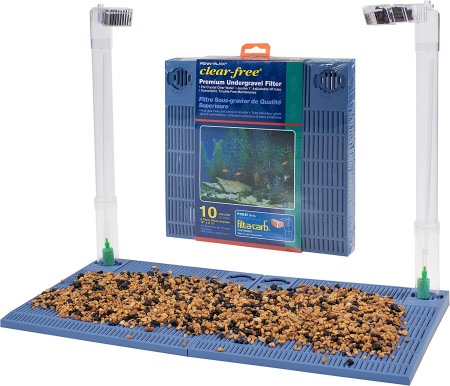| Back to Back Issues Page |
 |
|
The Goldfish Gazette, Issue #111 Under-Substrate Filters March 30, 2023 |
Goldfish Care TipsA Free Monthly Resource For Goldfish Enthusiasts In This Issue Under-substrate filters have a lot of advantages over hang-on-back, canister, or internal filters, but because they are cheap to buy and considered old technology, they are presumed to be inferior. Under-Substrate Filters
1. Profit margins on other filter types are much higher so they are promoted more heavily by sellers. 2. Myths about under-gravel filters still persist, mostly perpetuated by sellers of more expensive filters or misinformed social influencers. How an Under-Gravel Filter WorksMost reading this e-Zine know how under-gravel filters work, but for those that don’t know, the filter consists of a flat plastic tray that has slots in it that sits on the aquarium bottom under the substrate. Water is drawn up uplift tubes attached to the tray. As the water is drawn up the tubes using air bubbles or a powerhead, water is drawn down into the gravel. Very simple, very effective.There are a few tricks that enhance their efficiency considerably.
Advantages of Under-Gravel FiltersThey are cheap compared to most other filters, even when powerheads are installed.No maintenance is required on air driven filters as there are no moving parts. Under-gravel filters don’t need cleaning. In fact, cleaning them is a no-no. The brown sludge that accumulates under the filter is a colony of beneficial bacteria and other organisms. Deep vacuuming of the substrate should not be done as it disturbs the beneficial organisms established in the substrate. Under-gravel filters don’t leak, which is a common problem with lower priced external power filters. Leaks from these filters can cause expensive damage to floors. If renting, under-gravels are a much safer option. Under-gravel filters are the cleanest-looking internal filters with just a few uplift tubes to hide. Little space is taken up compared with say a sponge filter. Disadvantages of Under-Gravel FiltersMost of the disadvantages of under-gravel filters are either myths or misinformation spread by those selling high-priced alternatives.Under-gravel filters clog, especially in a planted aquarium. This is not the case. Some roots will find their way into the filter base plate, but not enough to hinder flow. Frequent cleaning is required. The opposite is the case. The only "cleaning" that needs to be done is possibly a yearly vigorous stirring up of the gravel during a large water change. Plants don’t do well in aquariums with under-gravels. The opposite is the case with the plants that are Goldfish tolerant such as Vallisneria. Under-gravel filters are nitrate factories. All filters are nitrate factories if they are doing their job properly. SummaryThe simplicity, cheapness and effectiveness of under-substrate filters is well proven.In hindsight, I should have used under-gravel filters with a powerhead for my aquarium hire business. Routine maintenance would have been simplified considerably. Gone would have been the constant fear of leaks from either the canister filters or hose connections. Comments? Ideas? Feedback? I'd love to hear from you. Just reply to this e-zine and tell me what you think, or what topics you want to be covered. Next Month's Topic Treating Hexamitawww.facebook.com/aboutgoldfish |
| Back to Back Issues Page |
